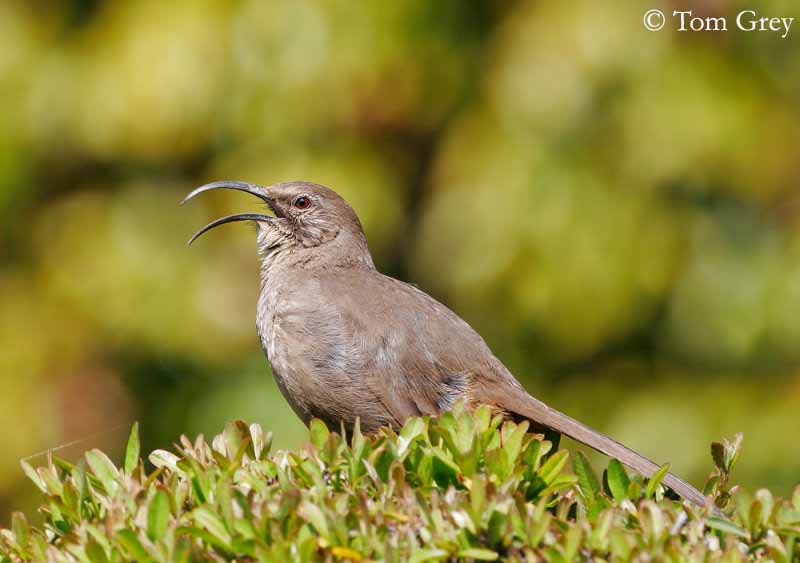
California Thrasher
Toxostoma redivivum
Passeriforme Order – Mimidae Family
BIOMETRICS :
Length : 32 cm
Wingspan : 36-41 cm
Weight : 78-93 g
LONGEVITY: up to 6 years
DESCRIPTION:
California Thrasher has dark upperparts. On the head, we can see pale eyebrow and dark cheeks. Tail is long and dark brown, with pale grey corners.
Underparts are slightly paler than upperparts, with pale throat contrasting with dark breast. Belly and undertail coverts are tawny buff.


Blackish bill is long and decurved. Eyes are dark. Legs and feet are blackish.
Both sexes are similar.
Immature resembles adults, but with paler plumage.
VOICE: SOUNDS BY XENO-CANTO
California Thrasher’s calls are low and flat « chuck » and « chur-erp » or a dry « chack ». The song is loud and sustained, a long series of warbled phrases, as guttural or musical phrases, repeated once or twice. It may imitate other songs species and sounds. It sings exuberantly year round.

HABITAT:
California Thrasher is common in lowland and coastal chaparral (many different types of terrains), and also in riparian woodland thickets, and urban areas such as parks and gardens.
RANGE:
California Thrasher is resident along coastal and inland California, and southwards to northern Baja California. Its dispersal is very limited.
BEHAVIOUR:
California Thrasher feeds on the ground, under cover. It swings its bill from side to side, forming arcs. It digs strongly into the leaf litter, turning over leaves with its beak, and peers deeply into these excavations. It runs for cover, raising its long tail.
California Thrasher rarely flies for any long distances. It walks along slowly, but covering a great territory in this manner.
California Thrasher is monogamous, and pairs are formed in winter. They are solitary nesters. Mated birds may often feed on the ground, close to each other.
During courtship display, male sings from high perch. Female may perform begging display and male presents her food or feeds her.

They are territorial birds, and they defend their territory.
California Thrasher sings from elevated perches, and mimics a wide range of species, birds, frogs, coyotes, and even postman’s whistle. Female also sings, and both male and female utter the same quality of sounds.
FLIGHT:
California Thrasher rarely flies in open land. It prefers to hide in dense vegetation. When it is flying, it performs swifts and shallow wing beats.
REPRODUCTION:
California Thrasher’s nest is hidden in dense vegetation, and built by both adults. It is a bulky bowl-shaped nest, made with coarse twigs, and lined with rootlets and fine materials.
Female lays 3 to 4 pale blue eggs, with dark spots. Incubation lasts about 14 days, by both parents. Chicks hatch altricial. They fledge at about 14 to 17 days. They are fed by both parents, by regurgitation for the first four days, and later, by large insects without wings and legs, removed by parents. Young remain in parental territory for 3 to 4 months.

This species produces two broods per year, sometimes three. Female lays a first clutch in February or March, and the second clutch follows very quickly, while male feeds the first chicks.
DIET:
California Thrasher feeds on insects and fruits. Insects are beetles and bugs, and it catches also spiders. It consumes fruits when available, berries, acorns and seeds.

PROTECTION / THREATS / STATUS:
California Thrasher is disturbed by habitat fragmentation and modifications. It is also threatened by the use of pesticides in orchards. Western Scrub jays are potential nest predators.
Fr: Moqueur de Californie
All : Sichelspottdrossel
Esp : Cuitlacoche de California
Ital : Mimo della California
Nd : Californische Spotlijster
Sd : Kalifornisk härmtrast
Photographs by Tom Grey
His website:
Tom Grey's Bird Pictures
Text by Nicole Bouglouan
Sources:
FIELD GUIDE TO THE BIRDS OF NORTH AMERICA by National Geographic Society - National Geographic Society - ISBN: 0792274512
WRENS, DIPPERS AND THRASHERS by Brewer David – illustrated by Barry Kent Mackay- Yale University Press - ISBN: 0300090595
All About Birds (Cornell Lab of Ornithology)
What Bird-The ultimate Bird Guide (Mitchell Waite)
The Birds of North America online